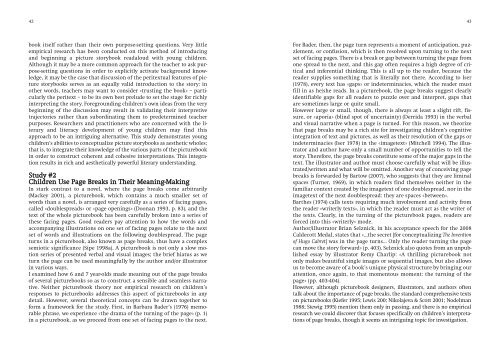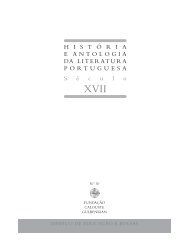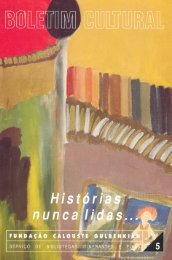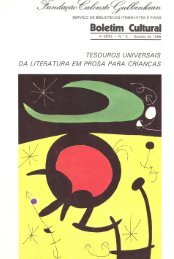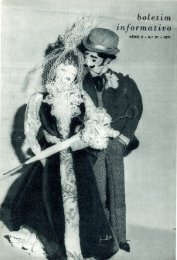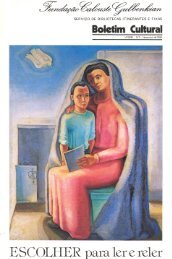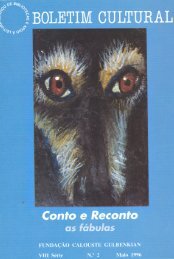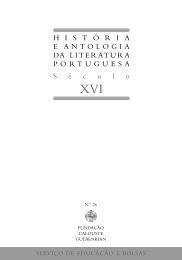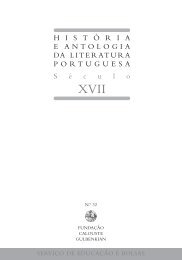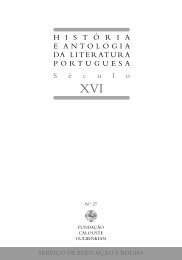Formar Leitores para Ler o Mundo - Leitura Gulbenkian - Fundação ...
Formar Leitores para Ler o Mundo - Leitura Gulbenkian - Fundação ...
Formar Leitores para Ler o Mundo - Leitura Gulbenkian - Fundação ...
Create successful ePaper yourself
Turn your PDF publications into a flip-book with our unique Google optimized e-Paper software.
42<br />
book itself rather than their own purpose-setting questions. Very little<br />
empirical research has been conducted on this method of introducing<br />
and beginning a picture storybook readaloud with young children.<br />
Although it may be a more common approach for the teacher to ask purpose-setting<br />
questions in order to explicitly activate background knowledge,<br />
it may be the case that discussion of the peritextual features of picture<br />
storybooks serves as an equally valid introduction to the story: in<br />
other words, teachers may want to consider «trusting the book» – particularly<br />
the peritext – to be its own best prelude to set the stage for richly<br />
interpreting the story. Foregrounding children’s own ideas from the very<br />
beginning of the discussion may result in validating their interpretive<br />
trajectories rather than subordinating them to predetermined teacher<br />
purposes. Researchers and practitioners who are concerned with the literary<br />
and literacy development of young children may find this<br />
approach to be an intriguing alternative. This study demonstrates young<br />
children’s abilities to conceptualize picture storybooks as aesthetic wholes;<br />
that is, to integrate their knowledge of the various parts of the picturebook<br />
in order to construct coherent and cohesive interpretations. This integration<br />
results in rich and aesthetically powerful literary understanding.<br />
Study #2<br />
Children Use Page Breaks in Their Meaning-Making<br />
In stark contrast to a novel, where the page breaks come arbitrarily<br />
(Mackey 2001), a picturebook, which contains a much smaller set of<br />
words than a novel, is arranged very carefully as a series of facing pages,<br />
called «doublespreads» or «page openings» (Doonan 1993, p. 83), and the<br />
text of the whole picturebook has been carefully broken into a series of<br />
these facing pages. Good readers pay attention to how the words and<br />
accompanying illustrations on one set of facing pages relate to the next<br />
set of words and illustrations on the following doublespread. The page<br />
turns in a picturebook, also known as page breaks, thus have a complex<br />
semiotic significance (Sipe 1998a). A picturebook is not only a slow motion<br />
series of presented verbal and visual images; the brief hiatus as we<br />
turn the page can be used meaningfully by the author and/or illustrator<br />
in various ways.<br />
I examined how 6 and 7 year-olds made meaning out of the page breaks<br />
of several picturebooks so as to construct a sensible and seamless narrative.<br />
Neither picturebook theory nor empirical research on children’s<br />
responses to picturebooks addresses this aspect of picturebooks in any<br />
detail. However, several theoretical concepts can be drawn together to<br />
form a framework for the study. First, in Barbara Bader’s (1976) memorable<br />
phrase, we experience «the drama of the turning of the page» (p. 1)<br />
in a picturebook, as we proceed from one set of facing pages to the next.<br />
For Bader, then, the page turn represents a moment of anticipation, puzzlement,<br />
or confusion, which is then resolved upon turning to the next<br />
set of facing pages. There is a break or gap between turning the page from<br />
one spread to the next, and this gap often requires a high degree of critical<br />
and inferential thinking. This is all up to the reader, because the<br />
reader supplies something that is literally not there. According to Iser<br />
(1978), every text has «gaps» or indeterminacies, which the reader must<br />
fill in as he/she reads. In a picturebook, the page breaks suggest clearly<br />
identifiable gaps for all readers to puzzle over and interpret, gaps that<br />
are sometimes large or quite small.<br />
However large or small, though, there is always at least a slight rift, fissure,<br />
or «aporia» (blind spot of uncertainty) (Derrida 1993) in the verbal<br />
and visual narrative when a page is turned. For this reason, we theorize<br />
that page breaks may be a rich site for investigating children’s cognitive<br />
integration of text and pictures, as well as their resolution of the gaps or<br />
indeterminacies (Iser 1978) in the «imagetext» (Mitchell 1994). The illustrator<br />
and author have only a small number of opportunities to tell the<br />
story. Therefore, the page breaks constitute some of the major gaps in the<br />
text. The illustrator and author must choose carefully what will be illustrated/written<br />
and what will be omitted. Another way of conceiving page<br />
breaks is forwarded by Bartow (2007), who suggests that they are liminal<br />
spaces (Turner, 1969), in which readers find themselves neither in the<br />
familiar context created by the imagetext of one doublespread, nor in the<br />
imagetext of the next doublespread: they are spaces «between».<br />
Barthes (1974) calls texts requiring much involvement and activity from<br />
the reader «writerly texts», in which the reader must act as the writer of<br />
the texts. Clearly, in the turning of the picturebook pages, readers are<br />
forced into this «writerly» mode.<br />
Author/illustrator Brian Selznick, in his acceptance speech for the 2008<br />
Caldecott Medal, states that «…the secret [for conceptualizing The Invention<br />
of Hugo Cabret] was in the page turns… Only the reader turning the page<br />
can move the story forward» (p. 403). Selznick also quotes from an unpublished<br />
essay by illustrator Remy Charlip: «A thrilling picturebook not<br />
only makes beautiful single images or sequential images, but also allows<br />
us to become aware of a book’s unique physical structure by bringing our<br />
attention, once again, to that momentous moment: the turning of the<br />
page» (pp. 403-404).<br />
However, although picturebook designers, illustrators, and authors often<br />
talk about the importance of page breaks, the standard comprehensive texts<br />
on picturebooks (Kiefer 1995; Lewis 200; Nikolajeva & Scott 2001; Nodelman<br />
1988; Stewig 1995) mention them only in passing, and there is no empirical<br />
research we could discover that focuses specifically on children’s interpretations<br />
of page breaks, though it seems an intriguing topic for investigation.<br />
43


